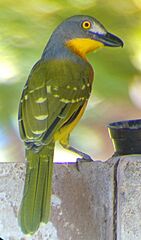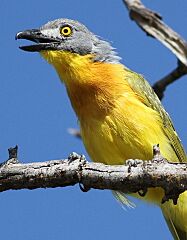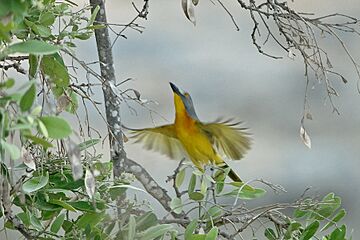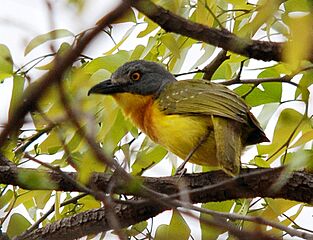Grey-headed bushshrike facts for kids
Quick facts for kids Grey-headed bushshrike |
|
|---|---|
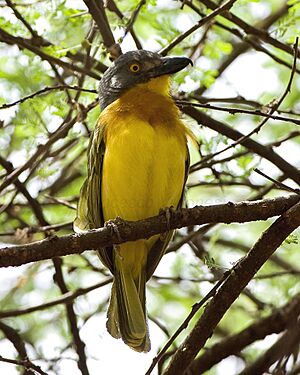 |
|
| Conservation status | |
| Scientific classification | |
| Genus: |
Malaconotus
|
| Species: |
blanchoti
|
The grey-headed bushshrike (Malaconotus blanchoti) is a type of passerine bird, also known as a songbird. People sometimes call it the ghostbird because of its spooky-sounding calls. This bird belongs to the Malaconotidae family.
You can find the grey-headed bushshrike across most of sub-Saharan Africa. However, it is not very common in Central Africa or the inner parts of southern Africa. It is the most common bird in its group, which includes large bushshrikes with big beaks and sad-sounding calls.
These birds usually live in wooded areas, especially in thick plants within dry or moist savannahs. They form pairs and stay together, living in woodlands with enough cover. They do not move around much, but they might travel a little after their young have grown up.
Contents
Different Types of Grey-headed Bushshrikes
Scientists recognize about six or seven different types, called subspecies, of the grey-headed bushshrike. These types often mix where their homes meet, so it can be hard to tell them apart in some places.
The main way to tell these subspecies apart is by the color of their feathers. For example, one type, M. b. approximans, has some chestnut (reddish-brown) color on its chest and sides. Another type, M. b. catharoxanthus, does not have this color at all. The type first discovered, M. b. blanchoti, has colors that are somewhere in between.
One subspecies, M. b. extremus, which lives in the furthest part of its range, has darker feathers on its back and belly. Another type, M. b. citrinipectus, has a bright lemon-yellow throat and upper chest.
What Does the Grey-headed Bushshrike Look Like?
Both male and female grey-headed bushshrikes look alike. They are about 22.6 to 25.2 centimeters long, from their beak to their tail. They have a strong, black beak and bright yellow eyes, which gives them a unique look.
Younger birds are generally lighter in color. Baby birds have pale yellow chests and brown stripes or spots on their heads. They also have brown eyes and brownish beaks.
The grey-headed bushshrike sometimes lives in the same areas as the orange-breasted bushshrike. The orange-breasted bushshrike looks similar but is smaller and has more delicate features.
Where Do They Live?
The grey-headed bushshrike lives in many different places. In some subtropical areas, you might find one pair living in about 200 hectares of land. A breeding pair might use an area of about 50 hectares.
In Zimbabwe, these birds are often found in miombo woodlands. They also live in semi-dry savannahs, but less often. You can also find them near rivers, in tall Acacia trees, and in thick evergreen forests.
They live from sea level up to 1,500 meters high. In Zimbabwe, they can be found up to 1,600 meters, and in tropical areas, sometimes even up to 3,000 meters. They do not like areas that get less than 500 mm of rain each year.
In southern Africa, they are not found in Kalahari woodlands. The orange-breasted bushshrike mostly replaces them in the Okavango Delta. Even though they often live near other bushshrike species, they are rarely found in areas with non-native trees. They are more common in gardens, but you might not notice them unless you hear their calls.
Behavior and Daily Life
What Do They Eat?
Grey-headed bushshrikes mainly eat insects. But they are also good hunters and will eat mice (swallowing them whole), small birds, snakes, lizards, and even chameleons.
Their Calls and Sounds
The most famous sound of the grey-headed bushshrike is the male's strange, mechanical-sounding hooting. This call is often repeated, especially before the breeding season. The male can hoot for an hour or more, making long, sad-sounding notes from a high spot. Sometimes, he makes a cluck or tic sound before he starts hooting.
Once the female starts sitting on the eggs, the male stops calling loudly. Instead, he brings her food. You might also hear softer sounds when you are close to them, along with quick clicks or clinks. They also have a harsh alarm call and a special call they use when singing together as a pair.
Reproduction and Life Cycle
Grey-headed bushshrikes have their babies in spring and summer. The male and female work together to build a nest in about 10 days. They hide the nest well in thick leaves, tangled branches, or mistletoe, usually in the middle or upper part of a tree. Their nest can look a bit like a small bird of prey's nest, and they might even use an old nest from another bird.
A female lays 2 to 4 cream-colored eggs. These eggs are about 29 x 21 mm and have irregular grey and brown spots, often forming a slight ring around the wider end. Only the female bird sits on the eggs, and they hatch after about 17 days. The female also takes care of the chicks, and they leave the nest when they are about three weeks old.
Gallery
-
This bird is looking for food in a Philenoptera tree in Kruger Park.



